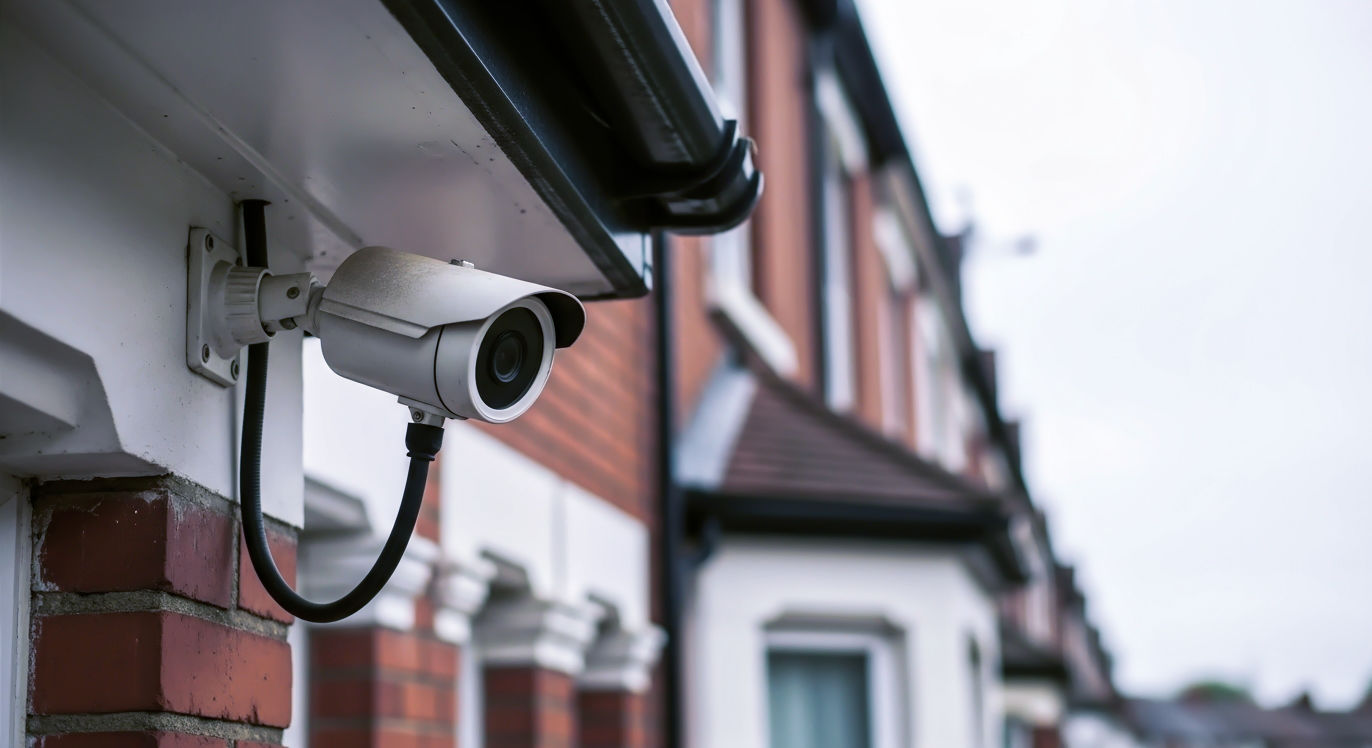The Great British Bluff: Are Dummy Surveillance Cameras a Smart Security Move or a Risky Gamble?
Discover if dummy CCTV cameras are a savvy security choice for your British home. This definitive guide covers legal rules, placement tips, and how to avoid fakes.

This post may contain affiliate links. If you make a purchase through these links, we may earn a commission at no additional cost to you.
It’s a familiar sight on almost any British street. Tucked under the eaves of a semi-detached house in Sheffield or fixed to the wall of a terraced home in Bristol, a small, dark object keeps a silent watch. A tiny red light blinks rhythmically, a tell-tale pulse in the twilight. It’s a CCTV camera, a modern-day gargoyle meant to ward off unwelcome visitors. But is it? Or is it a clever fake, a hollow piece of plastic that’s all bluff and no bite?
Welcome to the world of dummy surveillance cameras. For decades, they’ve been the go-to choice for homeowners and small business owners across the UK who want the deterrent effect of CCTV without the hefty price tag. They’re the security equivalent of putting a “Beware of the Dog” sign on your gate when the only thing guarding your house is a grumpy old cat.
But in an age of affordable smart doorbells and Wi-Fi cameras, do these decoys still have a place? Are they a savvy, budget-friendly security hack, or a risky gamble that could leave you dangerously exposed? This is the ultimate, no-nonsense guide for British residents. We’ll delve into the psychology of why a fake camera works, untangle the legal rules you need to know, show you how to choose a truly convincing model, and reveal the common blunders that can give the game away. By the end, you’ll know for sure whether the great British bluff is the right move for your home.
What Exactly Are Dummy Cameras and How Did They Become So Popular?
Before we get into the nitty-gritty, let’s be clear on what we’re talking about. A dummy camera is simply a non-functional device designed to look exactly like a real surveillance camera. And they’ve come a long way from the cheap, plasticky fakes of the past.
The Simple Definition: More Than Just Plastic Shells
Think of dummy cameras as scarecrows for burglars. Their entire job is to exist and be seen. They don’t record footage, they don’t capture images, and they certainly won’t alert you if someone is trying to force your back door. They are purely a psychological tool.
The market today is flooded with different types, ranging from basic plastic shells to incredibly sophisticated replicas. You can find:
- Basic Models: Simple casings that mimic the shape of a real camera.
- Models with Blinking LEDs: These are the most common type, featuring a small, battery-powered red light that flashes to simulate recording.
- Motorised Versions: Some higher-end fakes will slowly pan from side to side, creating a more convincing illusion of active monitoring.
- Hyper-Realistic Replicas: The best dummy cameras are often made using the actual casings of real CCTV cameras. They feature authentic lenses, realistic-looking infrared (IR) lights for “night vision,” and thick, weatherproof cables that appear to run into the wall.
A Quick Trip Through Security History
The rise of the dummy camera is directly linked to the explosion of CCTV in Britain. While video surveillance had been around for decades, it was in the 1980s and 90s that cameras started appearing all over our town centres and high streets. The UK quickly became one of the most-watched nations in the world. People began to associate the sight of a camera with security and, crucially, with the risk of being caught.
However, back then, a professional CCTV system was incredibly expensive. It was the preserve of big businesses and wealthy individuals, far beyond the reach of the average homeowner. This created a gap in the market. People wanted the deterrent effect that visible cameras provided, but they couldn’t afford the real thing.
And so, the dummy camera was born. It was a simple, genius solution: offer the look of security for a fraction of the price. For families and small shopkeepers, it was the perfect compromise. This legacy continues today. While real CCTV is now more affordable, the dummy camera remains a popular choice for those on a tight budget who are looking for a simple, proactive deterrent.
The Psychology of Deterrence: Why a Fake Camera Can Actually Work
It seems almost too simple, doesn’t it? How can a hollow piece of plastic possibly stop a criminal? The answer lies not in technology, but in human psychology. It’s all about making a burglar think twice.
The Burglar’s Mindset: A Game of Risk vs. Reward
Most burglars aren’t masterminds from a Hollywood film. They’re not meticulously planning a high-stakes heist. The vast majority are opportunistic. They are looking for an easy target—a house that appears unoccupied, a window left open, a door with a flimsy lock. Their goal is to get in and out as quickly as possible, with the lowest possible chance of being seen or caught.
A visible security camera, whether it’s real or fake, fundamentally changes their risk-reward calculation. Suddenly, the house is no longer an easy target. It presents a potential complication. The camera introduces the possibility of being recorded, identified, and prosecuted.
According to the Office for National Statistics, a high percentage of burglaries are not planned in advance. Criminals often make a split-second decision based on what they see. When faced with two similar houses, one with a visible camera and one without, which one do you think they’ll choose? They’ll almost always move on to the easier, less risky option. The dummy camera has done its job without ever recording a single frame.
The Power of the Blinking Red Light: A Visual Nudge
That little blinking red light is more powerful than you might think. It’s a visual cue, a constant, nagging reminder that says, “You are being watched.” In behavioural psychology, this is known as surveillance ambiguity. The uncertainty of whether the surveillance is real is often enough to alter behaviour.
Think about it in other contexts. When you see a “Wet Paint” sign, your first instinct isn’t to touch the wall to check if it’s true. You just avoid it. When you see a “Beware of the Dog” sign, you become a little more cautious. You accept the warning at face value because the consequences of being wrong aren’t worth the risk.
A dummy camera works in exactly the same way. For the opportunistic burglar, it’s simply not worth the gamble.
The Great Debate: Dummy Cameras vs. Real CCTV Systems
So, if dummy cameras can be so effective, why would anyone bother spending hundreds or even thousands of pounds on a real system? Because there is one enormous, game-changing difference between them. Let’s break down the pros and cons.
Round 1: The Cost Factor
This is the easiest round to score.
- Dummy Cameras: You can buy a convincing, high-quality dummy camera for less than £20. You can get a multi-pack for even less. There are no installation fees (it’s a simple DIY job), no monthly subscriptions, and no maintenance costs beyond a new set of AA batteries every year or so.
- Real CCTV: The cost of a real system is significantly higher. A basic DIY kit with a couple of cameras might start at around £200. A professionally installed, multi-camera system with a high-quality recorder could easily run to £1,000 or more. On top of that, many modern systems require a monthly subscription for cloud storage to save your footage.
Winner: Dummy Cameras, by a country mile.
Round 2: Installation and Maintenance
- Dummy Cameras: Installation is as simple as drilling a couple of holes and putting in some screws. You can have one up in ten minutes. The only maintenance is a quick wipe down to clear away cobwebs and changing the batteries for the LED light.
- Real CCTV: Installation can be a major headache. It often involves running wires through walls and ceilings, configuring the system to connect to your Wi-Fi network, and setting up the recording software. While DIY kits have become easier, many people still opt for professional installation, which adds to the cost. Maintenance involves cleaning lenses, checking connections, and ensuring the software is up to date.
Winner: Dummy Cameras.
Round 3: The Crucial Difference – Evidence
This is where the debate gets serious. This is the dummy camera’s Achilles’ heel.
- Dummy Cameras: They offer zero evidence. If someone breaks into your home, the dummy camera on your wall is nothing more than a plastic ornament. It provides nothing for the police to use in an investigation and nothing for your insurance company to support a claim. It’s a deterrent, and that’s it.
- Real CCTV: This is the entire point of a real system. It provides invaluable, hard evidence. High-definition footage can help police identify suspects, track their movements, and even spot the vehicle they used. It can be absolutely crucial in securing a conviction and can sometimes help in recovering your stolen possessions.
Winner: Real CCTV. It’s no contest.
The Verdict: Is There a Clear Winner?
There isn’t a simple winner because they serve two different purposes.
- Dummy cameras are a proactive deterrent. Their job is to prevent an incident from happening in the first place.
- Real CCTV is a reactive evidence-gathering tool. Its job is to help you deal with the aftermath of an incident.
The best choice for you depends entirely on your budget, the level of risk to your property, and what you want your security to achieve.
UK Law and the Fake Camera: What You Need to Know Before You Install
Putting up a security camera, even a fake one, might feel like a legal minefield. The good news is that for dummy cameras, the rules are very straightforward.
Are Dummy Cameras Legal in the UK? The Short Answer
Yes. It is perfectly legal to install dummy cameras on your own property. Because they don’t record any information, they aren’t subject to the complex laws that govern real CCTV systems.
The Grey Area: Privacy and Your Neighbours
This is where a bit of common sense and British courtesy comes in. Even though your camera is fake, you should avoid pointing it directly into your neighbour’s private spaces, like their living room windows, bedrooms, or back garden.
While you won’t be breaking any data protection laws (because you’re not recording), aiming a camera—even a fake one—at a neighbour’s private space could be interpreted as a form of harassment or intimidation. It could easily lead to an unpleasant dispute over the garden fence. The Information Commissioner’s Office (ICO), which regulates data protection in the UK, provides clear guidelines for domestic CCTV. While these don’t technically apply to dummy devices, following their spirit is the best practice: be considerate, respect your neighbours’ privacy, and only “film” what you need to protect your property.
Dummy Cameras and Data Protection (GDPR)
The General Data Protection Regulation (GDPR) and the Data Protection Act 2018 are designed to protect people’s personal data. This is a huge advantage of dummy cameras. Since they do not capture, record, or process any personal data, GDPR does not apply to them.
This saves you from the legal obligations that come with real CCTV. If a real camera captures images of people outside your property boundary (for example, on the public pavement or your neighbour’s drive), you have a legal duty to handle that data responsibly, including putting up signs and deleting footage when it’s no longer needed. With a dummy camera, you don’t have to worry about any of that.
The Ultimate Buyer’s Guide: How to Choose a Convincing Dummy Camera
The effectiveness of a dummy camera rests on one single factor: believability. A cheap, unconvincing fake won’t fool anyone. Here’s how to choose a model that looks the part.
Rule #1: Realism is Everything
An opportunistic burglar may not be a security expert, but they see real CCTV cameras every day. They have a good idea of what looks real and what doesn’t.
- Look for Authenticity: Your best bet is to choose a dummy camera that is an exact replica of a real, popular CCTV model you might see on shops and homes around the UK. Avoid generic, toy-like designs.
- Authentic Casing: Look for models with a casing made from aluminium or high-quality, weather-resistant plastic (ABS). Cheap, shiny plastic is a dead giveaway.
- Realistic Lens: The “lens” should be made of real glass or high-quality, dark plastic. It should look like a genuine optical component, not just a black circle painted on the front.
- Visible (and Believable) Wiring: This is one of the most important features. The most convincing dummy cameras have a short, thick, professional-looking cable that runs from the back of the camera into the mounting bracket or disappears into a hole you’ve drilled in the wall. This simple detail makes it look like a genuinely powered and connected device.
- Weatherproofing: Your camera will be exposed to the glorious British weather. Make sure it’s rated for outdoor use, otherwise it will quickly deteriorate and look fake.
Rule #2: The Blinking Light Dilemma
To blink or not to blink? That is the question.
- The Pro-Blink Argument: A blinking red light is a massive attention-grabber, especially at night. It makes the camera far more visible and screams “I am recording!”
- The Anti-Blink Argument: Here’s the catch. Many modern, professional CCTV systems do not have a constantly blinking red light. A savvy criminal might know this and see the blinking light as the tell-tale sign of a fake.
- The Verdict: The consensus is shifting. For maximum believability, consider a model that doesn’t have a main blinking light. Instead, look for one that has a ring of small infrared (IR) LEDs around the lens. On real cameras, these LEDs emit a faint, spooky red glow at night to enable night vision. A dummy camera that mimics this subtle glow is far more convincing than one with a single, pulsing disco light.
Rule #3: Dome, Bullet, or Turret? Matching the Camera to the Location
CCTV cameras come in several shapes, and choosing the right one for the location adds to the realism.
- Bullet Cameras: This is the classic, gun-barrel shape. They are highly visible and are great for sending a clear message. Because they point in a fixed direction, they are perfect for monitoring a specific area, like a driveway or a side alley.
- Dome Cameras: These are the discreet, semi-spherical cameras you often see on ceilings in shops. Their main advantage is that the dark, curved cover makes it impossible to tell which way the lens is pointing. This creates a sense of uncertainty for a potential intruder. They are also more vandal-resistant.
- Turret Cameras: Sometimes called “eyeball” cameras, these are a modern hybrid. They offer the easy-to-aim functionality of a bullet camera with the discreet look of a dome.
A good strategy is to use a mix. For example, a prominent bullet camera at the front of the house to act as a very visible deterrent, and a more discreet dome camera covering the back garden or patio.
Installation Masterclass: Where and How to Place Your Dummy Cameras for Maximum Effect
Buying a convincing camera is only half the battle. Where you put it is just as important. A well-placed camera looks professional and intimidating; a poorly placed one just looks fake.
Think Like a Burglar: Identifying Vulnerable Spots
Before you get your drill out, take a walk around your property and try to think like a criminal. Where would be the easiest places to get in?
- Primary Locations: The most obvious entry points are your front door, back door, and any easily accessible ground-floor windows or patio doors. These are the top priorities.
- Secondary Locations: Don’t forget side gates, which allow access to the back of your property, and driveways. You should also consider outbuildings like sheds and garages, as they are often targets for thieves.
The Golden Rules of Placement
- Visibility is Key: The whole point of a dummy camera is to be seen. Don’t hide it behind a hanging basket or a drainpipe. It needs to be clearly visible to anyone approaching your property.
- Plausible Positioning: Install it where a real camera would logically be placed. Good spots include under the eaves of the roof (which offers protection from the weather), next to a front or back door, or overlooking a vulnerable window.
- Height Matters: Place the camera high enough to be out of easy reach. You don’t want someone to be able to simply knock it off the wall. A good rule of thumb is around 3 metres (or 10 feet) off the ground. However, don’t place it so high that it’s barely visible from the ground. It needs to be noticeable.
- The Power of Combination: Dummy cameras work best as part of a layered security approach. Combining them with other visible deterrents, like motion-activated security lights or a smart doorbell, creates a much more convincing and formidable impression.
Don’t Forget the Warning Signs!
This is a simple but incredibly effective step that many people forget. Back up your bluff by placing a couple of professional-looking “CCTV in Operation” stickers on your windows or a small sign near your gate. These signs reinforce the message that your property is monitored and add another layer of psychological deterrence. It makes the whole setup seem much more official.
Common Mistakes to Avoid: How Not to Spoil the Illusion
You’ve bought a great camera and installed it in the perfect spot. Now, don’t fall at the final hurdle. Here are the common mistakes that can instantly give the game away.
- The “Too Good to Be True” Blunder: Avoid installing a state-of-the-art, expensive-looking dummy camera system on a house that has otherwise poor security. If you have rusty old window locks, a broken fence, and a front door that looks like it could be opened with a firm shove, a high-tech security camera looks completely out of place and suspicious. Your security measures should look consistent.
- The Cobweb Catastrophe: Nothing screams “fake and forgotten” like a camera covered in a thick layer of dust and draped with cobwebs. A real, functioning security camera is a valuable piece of equipment that a homeowner would keep clean. Give your dummy cameras a quick wipe with a cloth every few months to keep them looking maintained.
- The Dead Battery Giveaway: If your dummy camera has a blinking LED, for goodness sake, check the batteries regularly. A light that blinks for months and then suddenly stops is a clear signal to any observant criminal that the camera is a cheap, battery-operated fake.
- The Lone Camera Trap: While one camera is better than none, a single, lonely camera can sometimes look less convincing than a “system.” For the price of a couple of pints, you can buy two or three dummy cameras. Installing them at different points around your property (e.g., one at the front, one at the back) creates a much more believable impression of a comprehensive security setup.
The Future of Deterrence: Are Dummy Cameras Becoming Obsolete?
With smart doorbells from companies like Ring and Nest becoming increasingly common and affordable, is the humble dummy camera on its way out?
There’s no doubt that the price gap between real and fake is narrowing. You can now buy a basic real Wi-Fi security camera for under £50, which brings it into a similar price bracket as the most premium dummy cameras. These real cameras offer features that a dummy could only dream of, like motion alerts sent to your phone and two-way audio.
There’s also the argument that criminals are getting smarter and are more adept at spotting fakes. The professional burglar, the one who targets specific high-value homes, is unlikely to be fooled.
However, the dummy camera still has a vital role to play. Firstly, even an “affordable” real camera is still more expensive than a £10 dummy. And that £50 real camera might also come with a £3-a-month subscription fee, which adds up. For those on the tightest of budgets, the dummy camera remains the undisputed king of low-cost security.
Secondly, and most importantly, it still works on the most basic psychological level. It’s not about fooling a security expert; it’s about deterring the opportunist. And for that job, a visible, plausible deterrent will always have value.
Conclusion: The Final Verdict on Dummy Cameras for Your British Home
So, what’s the bottom line? Are dummy cameras a smart move or a silly risk?
The truth is, they are a tool—a limited but surprisingly effective one. You have to accept them for what they are: a low-cost, zero-maintenance, purely preventative measure. They can be highly effective at deterring the casual, opportunistic criminal who is looking for the path of least resistance. For the price of a takeaway pizza, you can make your home a less attractive target, and that is a powerful thing.
But you must also be brutally honest about what they are not. They are not a security solution. They offer no protection if someone does decide to break in. They will not help you identify the culprit, and they will not help you get your stolen belongings back.
Ultimately, dummy cameras are an excellent first line of defence. They are a brilliant addition to a layered security system, working alongside good locks, security lights, and a solid alarm. They are, perhaps, the ultimate British bargain: a simple, cheap, and quietly effective way to get a little more peace of mind. By using this guide to choose a realistic model and install it thoughtfully, you can make the great British bluff work for you.
Further Reading
For those wishing to explore home security in more detail, these resources provide authoritative and trusted information for UK residents:
- Secured by Design: The official police security initiative that provides guidance on crime prevention for the home. https://www.securedbydesign.com
- The Master Locksmiths Association: A non-profit body providing advice on locks, keys, and home security hardware from vetted professionals. https://www.locksmiths.co.uk
- The Information Commissioner’s Office (ICO): For definitive guidance on the legal use of domestic CCTV systems in the UK. https://ico.org.uk
- Neighbourhood Watch Network: A community-focused organisation with resources on preventing crime at a local level. https://www.ourwatch.org.uk






